What do B. Kliban, Lewis Caroll, Wal-Mart, McDonald's, Wittgenstein, and Harare, Zimbabwe have in common?
By Mark Fenton
Published May 18, 2007

I wanted to explore Upper James Street. I planned to start at the Mountain Brow, and walk at least to Fennell Avenue. In the past, my only pedestrian experience with this stretch of Upper James was accompanying a friend who was getting a tattoo here and wanted company.
That's always intrigued me. You choose a tattoo parlour out of the yellow pages and go to it because it's the one that's open that evening. No recommendation. The guy there is a shaggy character wearing a T-shirt and torn jeans and you haven't actually seen any of his artwork. And then you get him to put something under your skin that stays there forever.
I mean, I wouldn't choose a path of so little resistance even to buy something to hang on my wall. Perhaps tattooing presupposes a need for instant gratification. When I'm with someone with a tattoo, regardless of what the tattoo represents, the first thing it says to me is "This is a person with impulses, and this person follows those impulses."
Implied in this, I feel, is: "You, on the other hand, are equivocal, indecisive, and, I'd say, a bit meek."
I parked below this sign.
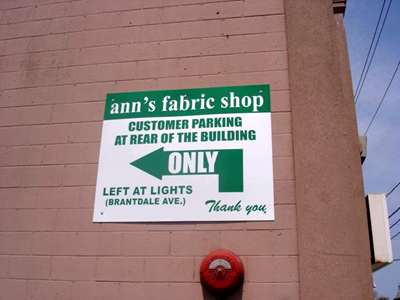
I puzzled over these intricate instructions for a few moments. Does the sign mean that the ONLY place one is allowed to park if patronizing ann's fabric shop is to the rear of the building, the course to which is an interesting L-shape?
Or does it mean that parking and ONLY parking can be done there, so that, following an exciting fabric purchase, a customer doesn't launch into some heavy-duty re-upholstering behind the store.
I decided it didn't apply to me. When I'm on a photo shoot I subscribe to an 'everything is permitted unless it's strictly forbidden' m.o. I wasn't going into ann's fabric shop, therefore, I could park anywhere I wanted to, including under this sign. Life had been good so far today. I felt invincible. I was pretty sure I could make my argument stick in court, should it come to that.
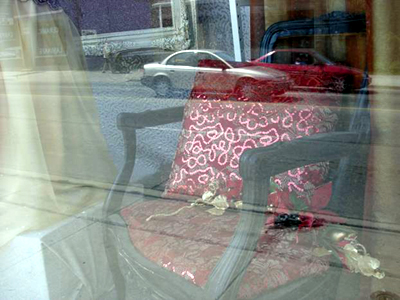
No one has ever called me a connoisseur of textiles, but I LOVE the fabric pictured above. The chair itself scares me. No back, just a loose cushion. And some fake flowers on the seat you'd probably have to move in order to sit down. You'd have to perch carefully and not lean back. Danger is part of the appeal though. Like the prospect of driving an old Lincoln with suicide doors.
But let's cut this tourist nonsense and get to the real reason I'm up here. As an adolescent I was obsessed with a mystery contained in the work of B. Kliban. As always I had done some surfing before going into the field. For an artist crucial in the admittedly specialized cannon of the single image cartoon, I was surprised how little web presence he has. Kliban is best known as the creator of a familiar Cat icon.
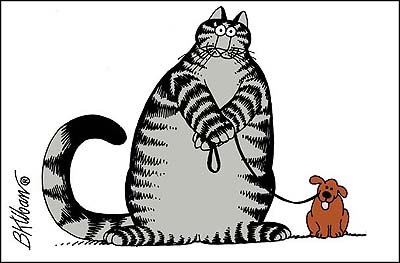
Of more interest to me though, are his surreal and cryptic cartoons, many of which still compel me today, partly because I can never claim to fully understand them. Appearing in the 70s and early 80s, they were noteworthy for relentless and largely unattractive nudity, oblique puns, gratuitous obscenity, and infinite manifestations of unpleasantness whose inspiration suggested a troubled imagination.
Like Koans, I would be on the verge of understanding them, and then all interpretations would slip away and they'd be more baffling than ever. In other words, as a teenager in Edmonton, this was the cartoonist I'd been waiting for.
There was, however, a group of cartoons, spanning more than one publication that fell relatively low on the bell curve of bad taste, were obviously conceived as a set, and which contained a truncated sign denoting a hardware store, cropped by the frame edge. The first one I came upon even had a title to make the concept clear.
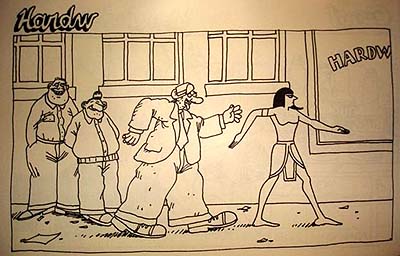
From B. Kliban: Never Eat Anything Bigger Than Your Head & Other Drawings, Workman Publishing Company, Inc., New York, 1976.
(I mentioned before, I don't clam to 'get' these cartoons, so don't even ask me to explain the lecherous rubby mimicking the life-sized hieroglyphic.) I wouldn't have thought any more about the obscure meaning of HARDW had it not made two further appearances in a subsequent publication, again truncated by the right edge of the frame. (Note that in all three drawings HARDW is, in some manner, doubled.)
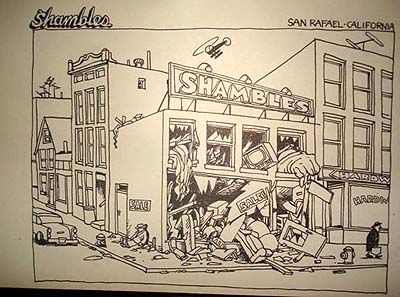
From B. Kliban. Two Guys Fooling Around With the Moon and Other Drawings. New York, Workman Publishing, 1982.
and
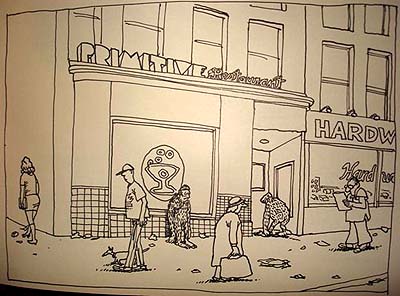
From B. Kliban. Two Guys Fooling Around With the Moon and Other Drawings. New York, Workman Publishing, 1982.
I try to force a meaning, but can't. The diversity of economic status, culture, historical context, and species in these drawings is too chaotic to bring under any system. Which, of course, made it that much more important to me that the relentless contrivance of HARDW deliver its meaning.
So this is the real reason for choosing this particular stretch of Hamilton roadway for today's photo tour. A few weeks before, having lived with the HARDW mystery for over two decades, I was driving along Upper James, and felt I may have stumbled on to a Kliban Rosetta Stone, right next door to ann's fabric shop. I was trembling as I photographed it.
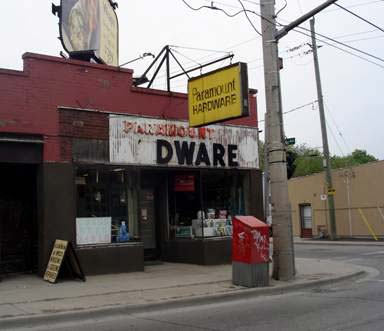
Yes, it's a truncated FIRST three letters rather than LAST three letters, and it's entropy to blame, rather than a frame edge, but the symmetry is there and let me tell you, it sure makes a bold statement even from a car window. And if it had actually been HARDW, rather than DWARE, the excitement might have caused me to go across the yellow line and have a serious accident.
So, Kliban volumes under my arm, I entered the shop, which seemed, to quote Alice Through the Looking Glass, "To be full of all manner of Curious things."
This quote comes from the chapter entitled "Wool and Water," the chapter in which Alice has been chatting with the White Queen who morphs into a sheep and becomes a shopkeeper and Alice subsequently tries to buy an egg from her and the egg morphs into Humpty Dumpty. (I often wonder that 20th Century Surrealists didn't give up and just golf or something, since Lewis Carroll had already done their work for them, and better.)
Anyway, although I couldn't put my finger on it, DWARE was similar in scale and simplicity, and like Alice, when I went in I felt I'd entered another time, or a parallel time, a little dream-like, maybe even a little backwards from the world outside.
As in the Alice chapter, I was the only customer, and yet again, as in the Alice chapter, at the very end of the shop was the proprietor, behind a counter, as though he had been waiting for me and me alone for as many years as it took me to arrive; yet who, for all that, was unsurprised by my arrival.
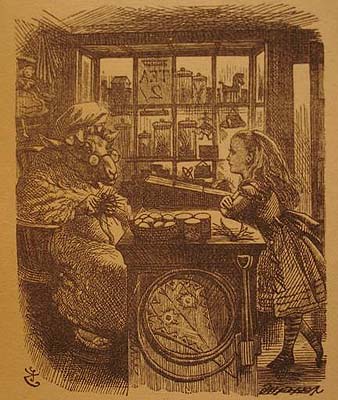
A man of about my age, grey work clothes, pencil in hand. He didn't bear an EXACT resemblance to the white queen after she's morphed into a sheep; I didn't bear an EXACT resemblance to Alice. Allow for that, but otherwise use the above illustration as your reference.
I resisted the urge to ask, "Would you be Mr. Dware?" I decided that if I wanted information I had better buy stuff. I am not without savvy when it comes to interviewing the manager and perhaps owner of a small business.
Maybe he'd query me on the books clutched tightly under my arm, maybe he wouldn't, but I wasn't so naïve as to ask him directly if he was familiar with the work of the late B. Kliban. "Do you have packing tape?" I asked. Everyone always need packing tape for something and can never find it.
"The clear stuff?" he answered, I nodded, he took me to it, and that was that. Readers, forget Home Depot and Canadian Tire for those small sundry items. At DWARE you do not have to fight to gain the attention of a sales rep and then be directed to another to find the location of an item as basic as packing tape.
Fast, professional, businesslike is how I would characterize this service. But I still didn't have what I needed. I had to buy time. Keep the ball rolling. I needed to pick an item I felt I was some authority on so as to launch a conversation, without having to drain my pockets to get the information I needed.
The tactic I hit on impressed even myself - at least at the time. "Oh, and do you have mousetraps."

Again he took me to them directly.
Here was my opportunity. I have tended to reside in old houses, with perhaps not the tightest foundations. Even with the full-time employment of a domestic cat, I have never managed to keep mice completely at bay. I wouldn't say I enjoy killing them, particularly as our family keeps rats for pets, to which I am emotionally attached, and mice, as I extricate them from their death machine, bear an unpleasant resemblance to our pets.
No one said all household tasks are pleasurable, or that all household tasks can be executed without violence.
By now I'm pretty good at setting them. It's all about using a very small amount of bait (I use peanut-butter) at the very centre of the trigger, and then bending it to be as HAIR-trigger as possible. As well as being easily tripped, this positioning generally causes the flipper to smack the mouse in the brain, killing him/her instantly and cleanly.
There is nothing I hate more than coming upon a squealing, paraplegic rodent hemorrhaging into that super-absorbent wood base, which trap is then too stained with gore for re-use.
(Note: I didn't set the trap pictured above, but rather, found it in our office building. It appears to be baited with something like a big ball of lard, roughly the size of the mouse's head. It was there in the same position last week ... buuut, I guess the guy who set it knows what he's doing.)
There are two kinds of Victor traps on the market these days. Mr. Dware sold both. On their respective utility I have strong opinions. There is a newer kind whose plastic yellow trigger, shaped like a slice of Swiss cheese, has two more or less unalterable settings, for two varying levels of sensitivity. My experience with these is that if the mouse actually jumps up and down on it, the trap COULD deploy. But generally the mouse just takes the bait and leaves.
These traps are obviously for the sportsman. The mouse killing equivalent of the angler who prefers fly-fishing to fishing with bait, because it requires more skill, and after all, he's not fishing to feed his family, he just likes being out on the water.Myself, if I set traps, I want mice gone ASAP. Different strokes. The ones with the copper trigger have an easily bendable flap which allows me absolute control (albeit I often set them SO lightly at first that they snap against my fingers while I'm preparing them such that I utter foul words, so I usually wait to set traps until after the children have gone to bed).
I didn't express the above argument verbatim to Mr. Dware, but I believe I hit all the points. The laconic Mr. Dware listened patiently, expressionless aside from shrugging in what I'll call a gesture of "the customer's always right" and, handing me the ones with the copper triggers, responded: "Well, they're the original."
This was the first time in my experience with retailers that I had no use for flawless service, and Mr. Dware had given me just that. Full points on the customer questionnaire if such an establishment had given one. How could I possibly now ask him the meaning of the missing letters form HARDWARE.
He wouldn't have said, "Gee I guess I should pay to get that fixed out of the profit on that tape and mousetrap you just bought," but he would have liked to. I thanked him. I said it was a great place and I'd definitely come again as I drove by it all the time. I didn't note a reaction.
I may not have gotten all the answers I wanted, but you can guess my imagination was firing on all cylinders. I moved North on foot and to hell with what they'd do to my car in that lot next to ann's fabric shop. I shot photos randomly and furiously. E.G.:
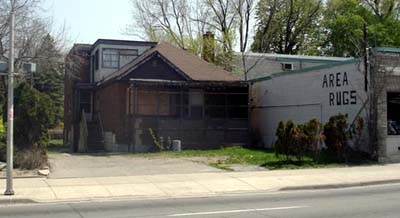
Imagine me walking past such structures, trying to read a meaning into everything. Expecting apes or ancient Egyptians to appear before them.
No one has ever said answers come easily in detective work, even in a metaphysical mystery like this one. As I walked South on James I scanned my memory for all the metaphysical mystery novels I'd read. The Da Vinci Code was no help. (Seen the movie; haven't read the book; not that interested in the premise.)
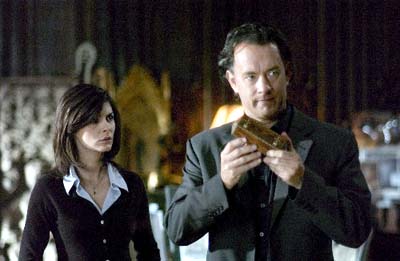
Audrey Tautou and Tom Hanks in The Da Vinci Code (Image Source: About.com)
No, the detective story I kept returning to was The Erasers (Les Gommes, 1953), by Alain Robbe-Grillet.
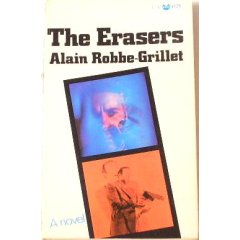
The erasers; (Evergreen black cat book)
It has been at least 20 years since I've read it, so my memory is dim. There is an assassin. There is a corpse. The killing happens over and over again, looping back on itself like a Mobius strip. There is a detective named Wallas. He may also be the assassin. The person the assassin assassinates may be his father. It also may be himself. We're never quite sure of these propositions or of anything else. I can guarantee you, the pages turn very, very slowly.
What intrigues me right now though is a passage, seemingly unrelated to anything, in which Wallas walks into a shop reminiscent of DWARE and examines a series of erasers, searching it seems for an exact degree of tactility. Memory fails me here. Normally an intense reader, I think I kept falling into bouts of narcolepsy as I read this book. I don't plan to reread it even for the purpose of making this photo essay slightly better.
At a certain point in the novel we are presented with an eraser, erased partially at both ends (I THINK by Wallas but correct me if you're a Robbe-Grillet trekky and know this stuff cold), such that the letters d-i-p are all that are printed on the remains of its unerased flat side.
I didn't get it. Neither, it appears, did French readers when it was first published. According to legend it was Samuel Beckett who deducted that the full word was Oedipus. Hence the son killing the father. I DO remember being baffled that this incident was kind of self-standing and wasn't related in any way to solving the mystery.
And I think a text which requires a future recipient of the Nobel Prize for Literature to decode it could be correctly described as opaque. Thinking about it years later, I sense a conspiracy. I imagine a phone call from a Paris phone booth. A rainy March evening in 1954.
Al: Sam! [Clipped Parisian diction, and please imagine I have the skill to write this dialogue in French]
Sam: Oh, Oh, Hi Al. I'm actually on the other line with my agent. [Spoken in grammatical, perhaps almost overly-correct schoolroom French. Hint of an Irish accent.]
Al: You are not! It's too late for that, and you're too drunk. Listen. That 2,000 Francs you lost from me at Gin Rummy last month.
Sam: Honestly Al...as soon as the royalties from my new play start coming through -
Al: Imbecile! Shut up and listen. I need you to write a letter. To Le Monde... La Figaro. Hell! Copy it all the papers, and all the literary reviews while you're at it. If you do this thing. I will eliminate the debt.
Sam: [mild suspicion mixed with failing attentiveness] Well...uh...I don't know. What is it you want me to say?
Al: It's the easiest 2,000 Franc debt you ever discharged. The bourgeoisie can't understand the simplest clue thrust under their noses. However pitiful it may sound, I actually require the use of your "reputation" to explain my new novel. You simply say you've read Les Gommes, and discovered an Oedipal subtext.
Sam: Here let me get a ...a pen...[long pause as Sam places the phone on his humidor. Unrepeatable mutterings on Al's end of the line including some French equivalent of "Celtic lout." Sound of what might be a Guinness being opened and poured at Sam's end.]
Sam: [Returning at last] OK. You said I'm supposed to write that I've...I've discovered an edible... um...
Al: Merde!...OEDIPAL you CRETIN!...O.E.D.I.P.A.L...Now listen careful. Obviously it is necessary for me to transcribe what it is you are to say - word for word -
It was such a scenario I played in my head as I walked Southward. Incidentally, if you want the Robbe-Grillet experience and are hungering for one of those nouvelle vague films about the obscure nature of memory and identity, I'd recommend Alain Resnais's L'Année Dernière à Marienbad for which Robbe-Grillet wrote the screenplay. Particularly if, like me, you can't afford airfare to upmarket French tourist destinations. Luxury accommodations. Snazzy apparel.
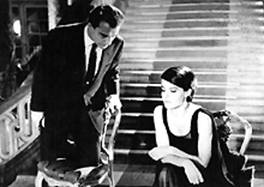
Last Year at Marienbad (Image Credit: Scenes of Cinema)
Barely knowing how I'd arrived here, I found myself in the parking lot of the Wal-Mart Plaza, looking at this inspiring wall.

A far cry from any cinematic memories of Marienbad, then or now. There was an age, I believe, when the idea of a shop was to have a street approach: an age when shop owners prided themselves on the appearance from the street, and even 'dressed' their front windows.
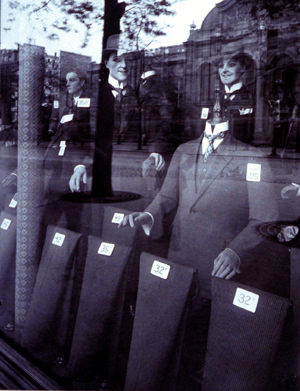
Eugene Atget, Mens Fashions. George Eastman House, Still Photograph Archive (Image Credit: geh.org)
A tradition, you may remember from earlier in this article, I am happy to see sustained in ann's fabric shop.
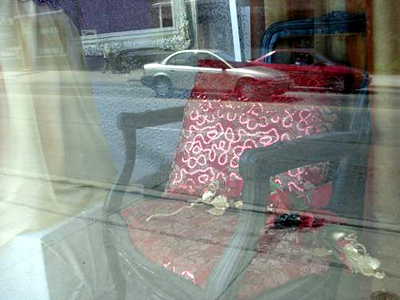
We don't expect that from a Mall in the Urban Sprawl. But what interests me here is that you can see the names of individual shops on the outside of the mall, without, of course, any way of accessing them other than going into the mall. I'm half curious to sketch the exterior of the mall, write down their order of these signs on it, and then rush inside to see if they do indeed serve as schematics for the positioning of the shops inside.
But I'm distracted from doing this when I notice the Golden Arch.
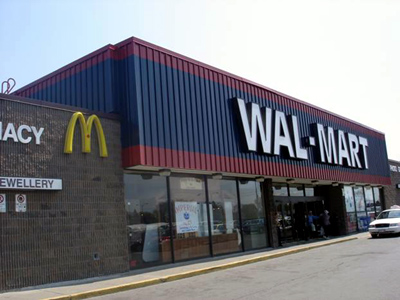
The Wal-Mart Experience is compelling. As is the McDonalds experience. The two combined, are way too much to resist.
There is something powerful at the very thought of passing into the mall,
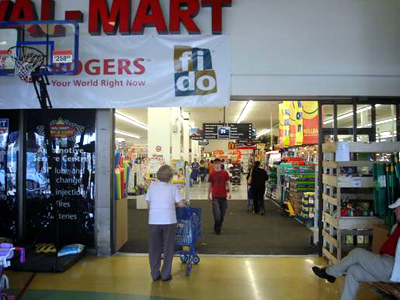
pausing briefly to read its messages,

and realizing that for purely anthropological reasons, this is where I'm destined to stop for lunch.
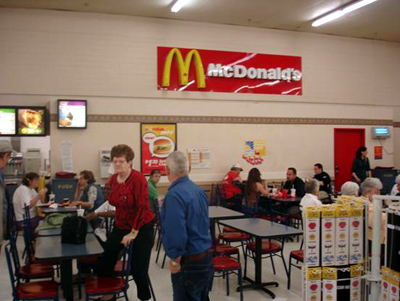
I am not coming in here to shop. I am simply passing through in order to have lunch at this SPECIFIC McDonalds. The idea is conceptually irresistible. It is, unfortunately, one of those rare days when I've come to work in a dress shirt and a tie. To quote Philip Marlowe in The Long Good-bye, "I belonged [here] like a Pearl Onion on a Banana Split."
By the way, those sticker-like products in the bottom left of the above photo are a Wal-Mart sales item, NOT part of the McDonalds. That's how open and flowing the space between the two multinationals is. Separated not by a wall, but by an emphatic red line,
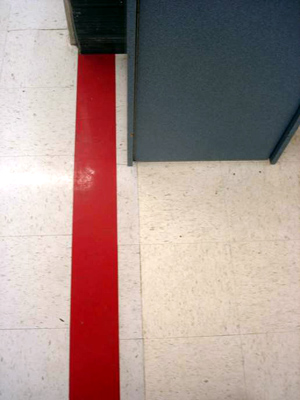
as I'm told siblings who share a room might do to demark territory, thus creating the perception of separateness.
It was time to put the camera away. I sensed that some of the customers had noticed me (a feeling that proved true when I went over my McDonalds establishing shot later).

I should mention that there is no smell of food whatsoever. (Decide for yourself if this is a good thing or a bad thing under the circumstances.) Diners are not far from the automotive section, and the smell is that ineffable mixture of molded polymer products, new steel, and industrial lubricant.
When I bought my "meal", which is what I think they call it in case you're not sure as you ingurgitate it, I prepared myself for the advertised McDonalds professional smile: the contrived smile, the smile that doesn't include the eyes, the smile smiled deliberately from forced energy on the part of the smiler - all well and good since why WOULDN'T I expect the person giving service to work at facial expression along with everything else - so I DON'T tip them. They get PAID, don't they?
What I got from the young woman at the counter was the opposite. She made no smile with her mouth, but instead made a heartfelt connection with her eyes, as one would expect between souls meeting in hell, each in search of a welcoming, fiery pit, but, alas, stuck wandering the outskirts.
"I hope you enjoy your meal and really hope you come again," she said, and meant it. I was disoriented. To get my bearings, I found a seat and began to go over what I had learned today.
I was still thinking about the clue in The Erasers, and how it could relate to my own puzzle. And then it hit me. I would simply turn the tactic inside-out. I grabbed a napkin and pen. Rather than erase the letters at the edge, I would find the overlap of the letters and erase THOSE. Here. I'll show you.
I wrote:
HARDW
Then I wrote:
DWARE
The letters in common were DW, thus:
harDWare.
Then I ERASED DW!!!!
Leaving:
Harare.
I Googled Harare on my Blackberry. There was an immediate wikipedia reference.
Harare (pronounced /'h? ??' ?i/, formerly Salisbury) is the capital of Zimbabwe. It has an estimated population 1,600,000, with 2,800,000 in its metropolitan area (2006). It is Zimbabwe's largest city and its administrative, commercial, and communications centre. It is a trade centre for tobacco, maize, cotton, and citrus fruits. Manufactures include textiles, steel, and chemicals, and gold is mined in the area. Harare is situated at an elevation of 4,865 feet (1,483 metres) and has a temperate climate.
There was even a photo,
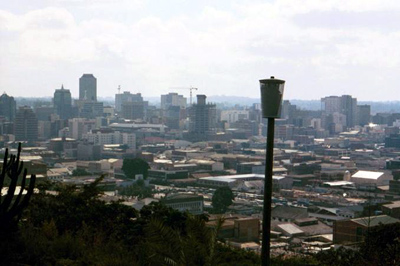
which bore a surprising resemblance to a photo I'd taken of Hamilton that morning
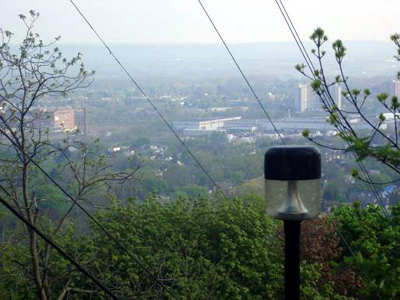
These connections were tenuous. But no more so, I believed, than the ratiocinative historical leaps in The Da Vinci Code. To quote Wittgenstein, "States of affairs fit together like links in a chain" (Tractatus Logico Philosophicus 2.03, and yeah, yeah, you're not the first person to tell me I'm reading Wittgenstein literally when I should be understanding these propositions to be only about language).
I closed my eyes and pictured events of the immediate future. I saw myself standing up and dumping out the contents of my tray. I saw myself straightening my tie, walking boldly behind the counter, forcing 5 dollars into the hand of the woman who'd sold me my meal, kissing her on the cheek and telling her to hang in there; that better times were ahead.
I saw myself leaving the restaurant and being met in the middle of Wal-Mart by security guards armed with rubber truncheons all of whom I would disable with a style of Wushu, all but unknown in the West. I saw myself exiting into the parkinglot to the knowledge that my Echo was still parked at ann's fabric shop, just as a Smart Car driven by Audrey Tautou screeched to a halt in front of me.
"Get in" she would shout. Just as well she was behind the wheel, what with my phobia about small, enclosed spaces... I closed my eyes. The last thing I need right now is to go into one of my spells...
I saw myself back in the office. Audrey gazing enigmatically out the window, as though deciding what jacket and skirt she was going to pack. I saw myself hitting the pre-programmed number for my travel agent. "Henri," I heard myself saying. "I need two seats on the next flight to Harare..."
By Economic Mip (anonymous) | Posted May 18, 2007 at 12:44:51
Well if you think they look similar, I won't argue. Of course that photo of Harare is at least seven years old. I think the main similarity you are seeing is the Rainbow Towers Hotel, which is a former Marriott, and as such follows a "normal" design for the hotel chain. Also, (before Mugabe destroyed the economy and the country) Britain was the colonial master, and set the city up in a well organized way, typical of many large British cities.
By jim parrott (anonymous) | Posted January 21, 2009 at 18:44:46
I too have been mesmerised/fascinated by Hardw. Imagine my surprise, on entering the town of Dauphin Manitoba from the South and, looking up, seeing on the second story side of a building Scott's Hardw as plain as day.
More puzzling, I recently watched The Wild Bunch - with Marlon Brando and Lee Marvin. As the gang of bikers sweep into town they are observed by two citizens (Mayor and Police Chief?) who are standing in front of a shop window with HARDW written on it. The camera pans past it quickly but it was like an electric shock. I can't get over the fact that I puzzled over Hardw in Kliban's books in the 80s, saw the sign in Dauphin around 99, and watched The Wild Bunch last year (2008).
What does this mean, and why am I still making these connections? Could there be more?
By Badly Drawn Dad (anonymous) | Posted November 02, 2011 at 17:45:18
More HARDW here
http://www.flickr.com/photos/dhedwards/galleries/72157625433057914/
You must be logged in to comment.
There are no upcoming events right now.
Why not post one?